#European follys
Photo



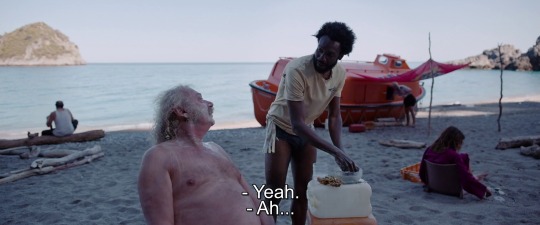
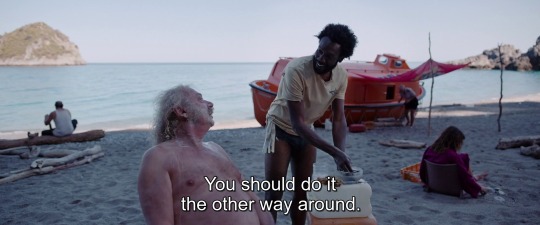

Sans filtre [Triangle of Sadness] (Ruben Östlund, 2022)
#Sans filtre#Ruben Östlund#black comedy#satire#top model#Harris Dickinson#Charlbi Dean#Dolly de Leon#Henrik Dorsin#Woody Harrelson#Vicki Berlin#Amanda Walker#Zlatko Burić#Jean-Christophe Folly#Sunnyi Melles#Oliver Ford Davies#life#European cinema#influencer#dating#money#gender roles#Triangle of Sadness#luxury#cruise#superyacht#millionaires#weapons manufacturers#capitalism#socialism
12 notes
·
View notes
Text
XV to XVIII Spanish rythms: Folia
It is a recurring Renaissance musical theme that, in addition to indicating two similar theme pieces, but with very defined characteristics is also used to designate a harmonic-melodic scheme used in hundreds of compositions from the late 15th century onwards. Its origins are in the Iberian Peninsula, from either the Kingdom of Portugal, León, or Valencia, in Spain (though it seems similar composition can be found at the end of the 15th century in Italy too).Taking the folía played specifically in Spain, Lully reduced the rhythm of the dance to suit his and Versailles’ taste, giving it the name folies d'Espagne.
youtube
youtube
youtube
youtube
youtube
Barroque dance: Folia d´Espagne with Marche de Turcs

#spain#folías#follies#portugal#france#spanish music#european music#barroque#barroco#renaissance#renacimiento#classic music#españa
8 notes
·
View notes
Text
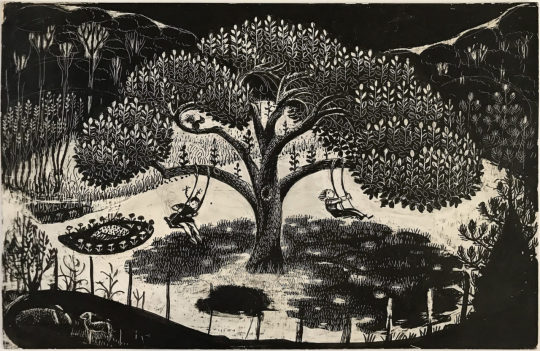

Virginia Lee Burton (1909-1968) was one of the most significant and groundbreaking children’s book author/illustrators of the 20th Century. Her classic books have never been out of print and are currently embraced by a fourth generation of early readers. This is an extraordinary achievement in the world of children’s picture books. The importance of early reading experiences to a child’s development is profound and Burton’s contribution to a child’s love of reading and ongoing literacy is significant.
Burton was at the forefront of the developing American Picture Book. Her dynamic illustrations, use of colour, space, typeface and design were a dramatic departure from the European picture books that were prevalent in the United States in the early 20th Century. Similarly, her themes of overcoming obstacles, meeting challenges, environmental awareness and adapting to change while honouring the past are evergreen and have a particularly American energy and spirit.
She also founded and led The Folly Cove Designers, a group of designer-craftsmen living on and around Cape Ann, north of Boston MA, which operated from the late 1930’s through the late 1960’s, and achieved international renown for the excellence of its block-printed textiles and designs.
For more information about Virginia Lee Burton go to www.virginialeeburton.com
86 notes
·
View notes
Text
Far away and long ago
One thing leading to another, I tried to watch A Princess for Christmas yesterday, prompted by my Peleș/Pelișor Anon answer and I have to say I am grinning as I write this post: it is, after all, a Hallmark movie, isn't it?
Maybe if I were drunk and/or in good company, it would have been easier. I was neither, so it was unwatchable. Even with the bits of personal nostalgia, knowing very well all the sets they used: from the two castles in Sinaia, to the Știrbei (princely) House private chapel in Buftea, to the Bragadiru Palace in Bucharest they obviously used for that ball. I finished skimming on fast forward for S and howled at this bit of Imdb trivia, I believe with all my heart to be wishful thinking:

Not only I do not believe ever seeing/hearing such a thing in all the interviews I have read/watched (of which they are a shameless handful), but it would be completely out of character for 'No Ego' 2014 S to declare such a preposterous thing (correct me if I am wrong, for I truly believe I am not).
Anyways. When it looks low budget, it is a low budget (with Eastern European logistics) D-series thing, despite all their efforts. Plot is downright stupid and the painful cheesiness permeating the slightest line uttered makes it unredeemable. Nuh-oh: not even to kill time, not even on a flight from Almaty to Saint Petersburg. No way.
Low budget is particularly apparent when it comes to costumes. This one, for example...

Her dress is ok-ish (heavily insisting on the -ish, here). But his uniform is an operetta reinterpretation of the Romanian Army's dorobanț (infantry) State Protocol uniform. An exact copy of the 1877 Independence War officer outfit (itself a Second Empire French uniform copycat, but that's just the historian in me nitpicking, of course):

The above is a very recent pic (2023 Remembrance Day festivities at a British War Cemetery near Bucharest). I know that place well, spent all my childhood 1 mile away, my grandparents owned a house in that village. It is a small, forlorn plot of infinite melancholy and a striking sight, with its carefully trimmed grass, among what used to be cornfields, circa 1984. 'This is British soil', my grandfather once told me and that made it both absurd and enticing: an alien enclave of sorts, a city of the dead. He was correct, by the way, and that gave our Remembrance Day expeditions a sort of strange, furtive charm. We always brought flowers and he, a former officer and POW, would always salute, bareheaded under heavy rain. But, I digress.
Both that movie and my recollections were far away and long ago. Mercifully so for S, at least. The difference in demeanor, profile and presence is undeniable, no matter what the Disgruntled Tumblrettes would tell you: some pushed the cheapness up to the gratuitous folly of 'he was a much better actor then'. Well, he wasn't: no chemistry with a female co-star who would clearly be more eager to have a dental surgery intervention. And no presence every time a very tired Roger Moore is around, which makes for roughly three-quarters of his part. But unlike many striving wannabes, he managed to pull out of the Prince Ashton (🙄) typecast and give us a very credible JAMMF, when starts aligned and with a surreal bit of luck.
If he could manage to pull out of the JAMMF typecast, I see great things. Until then, I will stand by my words: this is a guy with tremendous, but completely overlooked/untapped potential, who has been repeatedly miscast. And this is why what would immediately happen after OL is of critical importance. Brace yourselves.
On another, completely unrelated note: should I wait for that US copycat, disingenuous McTavish booze circus tour to end, in order to draw a line and my thoughts on his brand? I think I should, but always happy to oblige to public demand :)
66 notes
·
View notes
Text
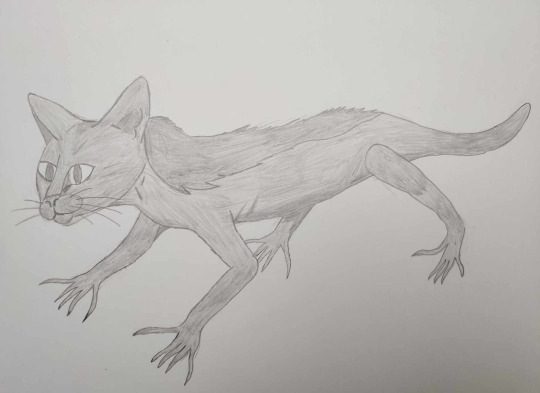
The Dard [French folklore]
Supernatural monsters that suck the milk out of cows are surprisingly common throughout European folklore. I suppose it was a way for farmers to explain why a perfectly normal, healthy cow suddenly didn’t give any more milk.
In the Vienne region of France, stories were told of a strange creature called ‘le dard’. According to Desaivre’s 1882 description, this animal was a snake with the head of a cat, a short tail and four legs. A furry mane ran along the creature’s spine.
Though the Dard is not venomous, it can deliver a vicious bite if provoked. In addition, these creatures are known to make a hideous hissing sound. They suck milk from cows' udders.
Curiously, some farmers in the region claimed to recognize the Dard’s likeness in the decorations on the columns of certain churches, though it’s not mentioned which ones.
Source:
Ellenberger, H., 1949, Le monde fantastique dans le folklore de la Vienne, Nouvelle revue des traditions populaires, 1(5), pp. 407-435.
(image source: me, hence the crude pencil drawing. I figured I could probably draw a cat’s head, right? Such is the folly of man!)
#French mythology#monsters#honestly I think I did pretty well#I'm fairly certain people care more about the text than the image anyway#mythical creatures#world mythology
41 notes
·
View notes
Text
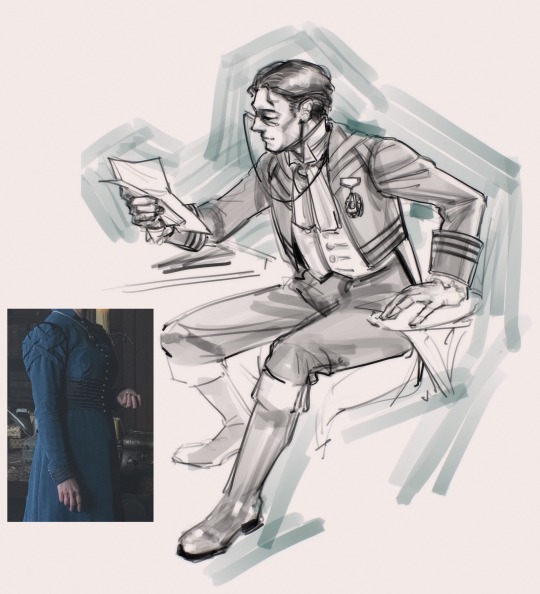
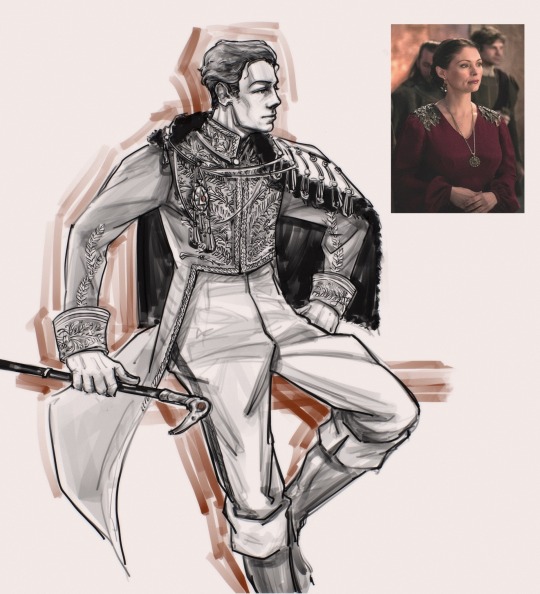
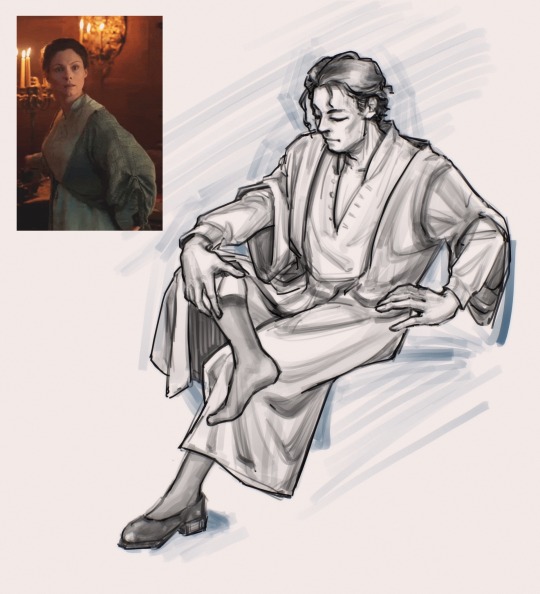
More "Tissaia, but a gentleman" folly for @ehay in fandomtrumpshate. If anybody can still recall it, I did some doodles for the same subject last year.
They are all Leyendecker studies. For those who are interested:
The teal dress with lattice pattern: is "translated" into a late Victorian/Edwardian suit with the same decorations, a high-buttoned waistcoat, plain shirt with winged collar and white cravat. Just another casual day dress.
The crimson ascension ball gown: hoo boy this gown was a tough one to design, the easy flow of the material gave it a more sensual, almost seductive feel compared to the rest of Tissaia's wardrobe, yet the deep colour and silver leaves decorations made it unmistakable a ball gown, or at least one for special occasion. My best bet was to go with "luxurious, seductive yet formal enough", and put "him" in dress uniform from the same time period, with a lot of leaf motif embroidery. A jacket draped over the shoulder making up for the lack of flow. Inspiration was mainly Hussar uniforms, which I think would fit well with The Witcher books' Central European/Slavic elements.
The comfy sleeping gown: Men also wore nightgown back then, so this was an easy job, no comment
#ehay#fandom trumps hate#sometimes i draw things#tissaia de vries#the witcher#finally finishing em!#see what I did there? day dress. evening dress. night gown. full day attire!#was both creatively challenging and. hell. the amount of details in that dress uniform. i croak.#but challenging and fun#okay for the next part: none of the following words are in the bible#go back now. i said it. go back#yeah. so. he dresses to make sure that in every room he walks into he must be the person with the tiniest waist#those sleeping gown buttons are undone for a reason too#i sexualise old men what's about it#contrary to popular belief i didnt yell 'old man p*ssy' the whole time i drew these. just occasionally#sorry ehay (giggling as i press post)#gent!tissaia
82 notes
·
View notes
Text
sometimes I have to just sit with the realization that I'm viewed from the outside as a deeply eccentric sower of bullshit artistry even though my intentions are always understandable and my thought process is always beyond reproach
for instance
I'm an ADHD-ridden motherfucker so I lose shit all the time. the most recent victim of my grand folly was my nice metal water bottle. it was a nice water bottle. a good size, good heft. I've used it as a hammer on more than one occasion to assemble small pieces of furniture. I love it! have no earthly idea where the fuck it went. which is an issue because I have to go to class, my first class after easter break. because of the aforementioned ADHD I need coffee to even have a prayer of getting through this in one piece. I have nothing to hold coffee in, and I've got about 60 cents in my bank account right now so no money to buy it on the way, either
the devil takes my idle hands and suddenly I know EXACTLY how to fix this problem. because I'm of noble and upright character I'm a fruity little european alcoholic as one might expect. and because (again) of the ADHD and also because I'm a lazy pos I still have a bunch of empty wine bottles kicking around from when I had a house party last month.
a voice of reason, possibly angelic in origin, tries to inform me that all this is a bit silly, isn't it, and maybe I should come up with another plan, but at that moment I'm too busy jamming sugar cubes down the neck of a wine bottle with the handle of a fork to really listen all that closely
which brings us to this very instance in time. this dream within a dream. the U6 is happily putting around the gürtel and there I sit, on my way to campus, drinking from a bottle of italian prosecco that just so happens to have coffee in it

people are looking
zum wohl, I fucking guess
#I'm increasingly convinced that my true purpose on this earth is to do deeply silly things very conspicuously in public#shitpost nach sacher art
11 notes
·
View notes
Text
As Russia ramps up its second offensive, a debate has erupted over whether Moscow or Kyiv will have the upper hand in 2023. While important, such discourse also misses a larger point related to the conflict’s longer-term consequences. In the long run, the true loser of the war is already clear; Russian President Vladimir Putin’s invasion of Ukraine will be remembered as a historic folly that left Russia economically, demographically, and geopolitically worse off.
Start with the lynchpin of Russia’s economy: energy. In contrast to Europe’s (very real) dependence on Russia for fossil fuels, Russia’s economic dependence on Europe has largely gone unremarked upon. As late as 2021, for example, Russia exported 32 percent of its coal, 49 percent of its oil, and a staggering 74 percent of its gas to OECD Europe alone. Add in Japan, South Korea, and non-OECD European countries that have joined Western sanctions against Russia, and the figure is even higher. A trickle of Russian energy continues to flow into Europe, but as the European Union makes good on its commitment to phase out Russian oil and gas, Moscow may soon find itself shut out of its most lucrative export market.
In a petrostate like Russia that derives 45 percent of its federal budget from fossil fuels, the impact of this market isolation is hard to overstate. Oil and coal exports are fungible, and Moscow has indeed been able to redirect them to countries such as India and China (albeit at discounted rates, higher costs, and lower profits). Gas, however, is much harder to reroute because of the infrastructure needed to transport it. With its $400 billion gas pipeline to China, Russia has managed some progress on this front, but it will take years to match current capacity to the EU. In any case, China’s leverage as a single buyer makes it a poor substitute for Europe, where Russia can bid countries against one another.
This market isolation, however, would be survivable were it not for the gravest unintended consequence of Russia’s war—an accelerated transition toward decarbonization. It took a gross violation of international law, but Putin managed to convince Western leaders to finally treat independence from fossil fuels as a national security issue and not just an environmental one.
This is best seen in Europe’s turbocharged transition toward renewable energy, where permitting processes that used to take years are being pushed up. A few months after the invasion, for example, Germany jump-started construction on what will soon be Europe’s largest solar plant. Around the same time, Britain accelerated progress on Hornsea 3, slated to become the world’s largest offshore wind farm upon completion. The results already speak for themselves; for the first time ever last year, wind and solar combined for a higher share of electrical generation in Europe than oil and gas. And this says nothing of other decarbonization efforts such as subsidies for heat pumps in the EU, incentives for clean energy in the United States, and higher electric vehicle uptake everywhere.
The cumulative effect for Russia could not be worse. Sooner or later, lower demand for fossil fuels will dramatically and permanently lower the price for oil and gas—an existential threat to Russia’s economy. When increased U.S. shale production depressed oil prices in 2014, for example, Russia experienced a financial crisis. Lower global demand for fossil fuels will play out over a longer timeline, but the result for Russia will be much graver. With its invasion, Russia hastened the arrival of an energy transition that promises to unravel its economy.
Beyond a smaller and less efficient economy, Putin’s war in Ukraine will also leave Russia with a smaller and less dynamic population. Russia’s demographic problems are well-documented, and Putin had intended to start reversing the country’s long-running population decline in 2022. In a morbid twist, the year is likelier to mark the start of its irrevocable fall. The confluence of COVID and an inverted demographic pyramid already made Russia’s demographic outlook dire. The addition of war has made it catastrophic.
To understand why, it’s important to understand the demographic scar left by the 1990s. In the chaos that followed the Soviet Union’s dissolution, Russia’s birthrate plunged to 1.2 children per woman, far below the 2.1 needed for a population to remain stable. The effects can still be seen today; while there are 12 million Russians aged 30-34 (born just before the breakup of the Soviet Union), there are just 7 million aged 20-24 (born during the chaos that followed it). That deficit meant Russia’s population was already poised to fall, simply because a smaller number of people would be able to have children in the first place.
Russia’s invasion has made this bad demographic hand cataclysmic. At least 120,000 Russian soldiers have died so far—many in their 20s and from the same small generation Russia can scarcely afford to lose. Many more have emigrated, if they can, or simply fled to other countries to try to wait out the war; exact numbers are hard to calculate, but the 32,000 Russians who have immigrated to Israel alone suggest the total number approaches a million.
Disastrously, the planning horizons of Russian families have been upended; it is projected that fewer than 1.2 million Russian babies may be born next year, , which would leave Russia with its lowest birthrate since 2000. A spike in violent crime, a rise in alcohol consumption, and other factors that collude against a family’s decision to have children may depress the birthrate further still. Ironically, over the last decade Putin managed to slow (if not reverse) Russia’s population decline through lavish payoffs for new mothers. Increased military spending and the debt needed to finance it will make such generous natalist policies harder.
The invasion has left Russia even worse off geopolitically. Unlike hard numbers and demographic data, such lost influence is hard to measure. But it can be seen everywhere, from public opinion polls across the West to United Nations votes that the Kremlin has lost by margins as high as 141 to 5. It can also be seen in Russia’s own backyard; while an emboldened NATO could soon include Sweden and Finland, Russia’s own Collective Security Treaty Organization is tearing at the seams as traditional allies such as Kazakhstan and Armenia realize the Kremlin’s impotence and look to China for security.
Perhaps most important of all, Russia has reinvigorated the cause of liberal democracy. In the year after its invasion, French President Emmanuel Macron won a rare second term in France, the far-right AfD lost ground in three successive elections in Germany, and “Make America Great Again” Republicans paid an electoral penalty in the U.S. midterms. (The far right did sweep into power in both Sweden and Italy, but such wins have so far failed to dent Western unity and appear more motivated by immigration.) And this says nothing of the wave of democratic consolidation playing out across Eastern Europe, where voters have thrown out illiberal populists in Slovenia and Czechia in the last year alone. It is impossible to attribute any of these outcomes to just one factor (U.S. Democrats also got a boost from the overturn of Roe v. Wade and election denialism, for example), but Russia’s invasion—and the clear choice between liberalism and autocracy it presented—no doubt helped.
Nowhere, however, has Russia’s invasion backfired more than in Ukraine. Contrary to Putin’s historical revisionism, Ukraine has long had a national identity distinct from Russia’s. But it’s also long been fractured along linguistic lines, with many of its elites intent on maintaining close relations with the Kremlin and even the public unsure about greater alignment with the West.
No longer. Ninety-one percent of Ukrainians now favor joining NATO, a figure unthinkable just a decade ago. Eighty-five percent of Ukrainians consider themselves Ukrainian above all else, a marker of civic identity that has grown by double digits since Russia’s invasion. Far from protecting the Russian language in Ukraine, Putin appears to have hastened its demise as native Russian speakers (Ukrainian President Volodymyr Zelensky included) switch to Ukrainian en masse. Putin launched his invasion to bring Ukraine back into Moscow’s orbit. He has instead anchored its future in the West.
Of course, one can argue that, however much the war has cost Russia, it has cost Ukraine exponentially more. This is true. Ukraine’s economy shrank by more than 30 percent last year, while Russia’s economy contracted by just about 3 percent. And this says nothing of the human toll Ukraine has suffered. But, like Brexit, Western sanctions on Russia will play out as a slow burn, not an immediate collapse. And while Russia enters a protracted period of economic and demographic decline, once peace comes, Ukraine will have the combined industrial capacity of the EU, United States, and United Kingdom to support it as the West’s newest institutional member—precisely the outcome Putin hoped to avoid. Russia may yet make new territorial gains in the Donbas. But in the long run, such gains are immaterial—Russia has already lost.
48 notes
·
View notes
Photo





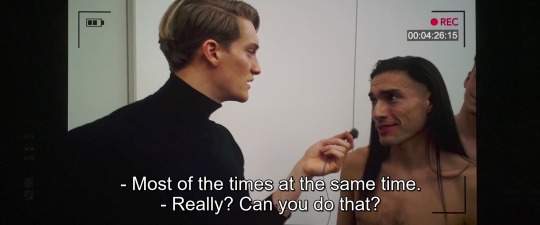

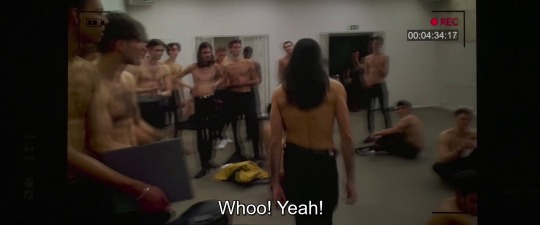
Sans filtre [Triangle of Sadness] (Ruben Östlund, 2022)
#Sans filtre#Ruben Östlund#black comedy#satire#top model#Harris Dickinson#Charlbi Dean#Dolly de Leon#Henrik Dorsin#Woody Harrelson#Vicki Berlin#Zlatko Burić#Amanda Walker#Jean-Christophe Folly#Sunnyi Melles#Oliver Ford Davies#life#European cinema#influencer#dating#money#gender roles#Triangle of Sadness#luxury#cruise#superyacht#millionaires#weapons manufacturers#capitalism#socialism
3 notes
·
View notes
Text
2023 Book List
Unbelievably I read a staggering 70 books in 2023! The most ever! My only disappointment is NOT finishing Dracula Daily, I came so close...
Wolf Brother Michelle Paver
Skin-Walker Michelle Paver
Be the Serpent Seanan McGuire
She Who Became the Sun
Soul-Eater Michelle Paver
Nona the Ninth Tamsyn Muir
The Girl in Red Christina Henry
As yet Unsent Tamsyn Muir
Outcast Michelle Paver
Leonard Cohen: On a wire Philippe Girard
Oath Breaker Michelle Paver
Ghost Hunter Michelle Paver
Baggage: Tales from a Fully Packed Life Alan Cumming
M is for Magic Neil Gaiman
Silverwing Kenneth Opal
Last Violent Call Chloe Gong
Malice: Malice Duology #1 Heather Walter
Pandora Susan Stokes-Chapman
A Lady for a Duke Alexis Hall
Boyfriend Material Alexis Hall
Emily Wilde’s Encyclopedia of Faeries Heather Fawcett
Motorcycles & Sweetgrass Drew Hayden Taylor
Conventionally Yours Annabeth Albert
The Unbalancing R.B Lemberg
Stone Blind Natalie Haynes
The Winter Soldier: Cold Front Mackenzi Lee
Ruby Nina Allan
The Strange Case of the Alchemist’s Daughter Theodora Goss
Husband Material Alexis Hall
The Secret Service of Tea and Treason India Holton
My Dear Henry: A Jekyll and Hyde Remix Kalynn Bayron
The Monsters we Defy Leslye Penelope
Travelers Along the Way: A Robin Hood Remix Aminah Mae Safi
Madly, Deeply: The Diaries of Alan Rickman Alan Rickman
Morgan Is My Name Sophie Keetch
Threads That Bind Kika Hatzopoulou
European Travel for the Monstrous Gentlewoman Theodora Goss
Feeling Sorry for Celia Jaclyn Moriarty
Daughter of the Pirate King Tricia Levenseller
A Clash of Steel: A Treasure Island Remix C.B. Lee
Harley Quinn: The Animated Series: The Eat. Bang! Kill. Tour Tee Franklin
Magic for Liars Sarah Gailey
The Story of Owen Emily Kate Johnston
The Brilliant Death A.R. Capetta
Circle of Magic: Sandy’s Book Tamora Pierce
The Merry Spinster: Tales of Everyday Horror Daniel M. Lavery
Death's Detective- Malykant Mysteries #1-4 Charlotte E. English
The Salt Grows Heavy Cassandra Khaw
A Touch of Darkness- Hades & Persephone #1 Scarlett St. Clair
Mortal Follies Alexis Hall
Witch King Martha Wells
The London Séance Society Sarah Penner
A Life on Our Planet: My Witness Statement and a Vision for the Future David Attenborough, Jonnie Hughes
A Game of Fate- Hades Saga #1 Scarlett St. Clair
Immortal Longings Chloe Gong
Hooked Emily McIntire
Foul Heart Huntsmen Chloe Gong
Signal to Noise Silvia Moreno-Garcia
Daughter of the Siren Queen Tricia Levenseller
Starter Villain John Scalzi
The Sinister Mystery of the Mesmerizing Girl Theodora Goss
Starling House Alix E. Harrow
A Marvellous Light: The Last Binding #1 Freya Marske
A Restless Truth: The Last Binding #2 Freya Marske
Thornhedge T. Kingfisher
What the River Knows Isabel Ibanez
The In-Between: Unforgettable Encounters During Life's Final Moments Hadley Vlahos
Misrule: Malice Duology #2 Heather Walter
The Raven and The Reindeer T. Kingfisher
A Power Unbound: The Last Binding #3 Freya Marske
I started some series, and I finished some series. I found new favourite authors and revisited some old favourites. Please take them as recommendations, or if you have read any of the same books come talk about them with me!
Reminder you can also follow me on The Storygraph to see what I am reading in real time, where I am simply shy_fairy
Previous Years Reading lists can be found here: 2022 2021 2020 2019 2018 2017 2016 2015
#book list#level reads#2023 reading list#ask me what I'm reading#talk books to me#books#reading list
5 notes
·
View notes
Text
Deep dives into folklore: Giants

The concept of giants has captivated the human imagination for millennia, transcending cultural and geographical boundaries. Giants have played a prominent role in folklore, mythology, literature, and fairytales, taking on various forms and roles in different contexts. Today I am trying a new format for deep dives into folklore and exploring the evolution of giants in these diverse realms, tracing their origins, transformation, and significance throughout history.
Giants have deep roots in human storytelling. They first appeared in folklore and mythology as ancient beings, often representing the raw power of nature. In Norse mythology, the frost giants were personifications of the primal forces of ice and cold, as seen in the character of Ymir, from whose body the world was formed. Similarly, Greek mythology featured giants like the Titans, who predated the Olympian gods, embodying the forces of chaos and primordial creation.
In many cultures, giants were often depicted as menacing beings, threatening the natural order and the gods themselves. This portrayal can be seen in the biblical story of David and Goliath, where the giant Goliath symbolizes an overwhelming adversary to be conquered by the underdog hero. These early portrayals of giants set the stage for their evolution in later narratives.
As literature developed, giants evolved from mere mythological entities into more complex characters with distinct personalities and roles. The medieval and Renaissance periods witnessed a significant transformation of giants in European literature. They were no longer just monstrous adversaries but characters with moral and symbolic significance.
One of the most famous literary giants is found in Jonathan Swift's "Gulliver's Travels." In this satirical work, giants are used as a metaphor to criticize the follies of human society. Swift's giants, the Brobdingnagians, are portrayed as physically imposing but morally virtuous, underscoring the idea that physical size does not equate to moral stature. This shift in the portrayal of giants from pure antagonists to complex characters reflects the evolving human understanding of the world and society.
Fairytales offer another fascinating lens through which to view the evolution of giants. In fairytales, giants often serve as obstacles to be overcome by brave heroes, like Jack in "Jack and the Beanstalk." These tales not only entertain but also convey moral lessons, emphasizing the virtues of courage, resourcefulness, and wit in the face of adversity.
Giants in fairytales can also be seen as symbolic representations of the fears and challenges children encounter as they grow up. The giant becomes a projection of the child's own insecurities and anxieties, personifying the daunting world that must be conquered to transition into adulthood.
In modern literature and pop culture, giants continue to evolve and adapt to contemporary concerns and themes. Giants can symbolize environmental threats, economic disparities, or societal injustices. For instance, in Roald Dahl's "The BFG," the Big Friendly Giant becomes a symbol of empathy and the power of friendship, contrasting with the other, more sinister giants who represent greed and malevolence.
In the realm of cinema, giants have made their mark in films like "The Iron Giant" and "Attack on Titan," exploring themes of alienation, identity, and the consequences of war. These modern interpretations demonstrate how the concept of giants remains relevant and adaptable to the ever-changing concerns of society.
The evolution of giants in folklore, mythology, literature, and fairytales reflects the evolution of human society and thought. From primal forces in ancient mythologies to complex characters in literature and fairytales, giants have been used to convey a wide range of meanings and moral lessons. They continue to captivate our imaginations, providing a bridge between the ancient and the modern, while adapting to address the pressing concerns of each era. Giants remain a testament to the enduring power of storytelling to convey timeless truths and reflect the ever-changing human experience.
Taglist (reply/reblog to be added):
@axl-ul @crow-flower @thoughts-fromthevoid @alderwoodbooks @harleyacoincidence @tuberosumtater @sonic-spade @theonlygardenia @holymzogynybatman @nulliel-tres
#writeblr#writers of tumblr#writing#bookish#booklr#fantasy books#creative writing#book blog#ya fantasy books#ya books#folklore#deep dives into folklore#giants#attack on titan#the iron giant#roald dahl#the bfg
6 notes
·
View notes
Text
To find a personality that captures the sheer inhuman vacuousness of Trump’s anti-ideology, we have to look to literature, and specifically to Robert Musil’s masterpiece The Man Without Qualities. Written during the interwar years and left uncompleted at Musil’s death in 1942, The Man Without Qualities is an autopsy of the varieties of European intellectual pretense and folly in the years leading up to World War I, as well as a search for a more viable alternative. The character who concerns us is Christian Moosbrugger, a working-class murderer of women who becomes an object of fascination for many of the characters in the novel and of the Vienna they inhabit. During his trial for the brutal murder of a prostitute, he becomes a celebrity, due to his cavalier and eccentric manner.
[...]
Possessing the same Will-to-Fame as Trump, Moosbrugger
embarks on his course as though guided by outside forces.
In the judge’s eyes, Moosbrugger was the source of his acts; in Moosbrugger’s eyes they had perched on him like birds that had flown in from somewhere or other. To the judge, Moosbrugger was a special case; for himself he was a universe, and it was very hard to say something convincing about a universe.
Musil’s core insight is that Moosbrugger possesses a cosmic sense of himself that removes him from the world of human agency and responsibility, akin to Strawson’s objective attitude. Moosbrugger’s indifference to all values and to the very idea of values threatens yet fascinates, since it offers us the freedom to give voice to our most egregious selves and see them reflected back at us not as human qualities but as forces of nature. So it is with Trump, a catalyst that transforms resentment and worship into fame. Elsewhere, Musil describes Moosbrugger’s dissolution of self into universe in this way:
Anyone can conceive of a man’s life flowing along like a brook, but what Moosbrugger felt was his life flowing like a brook through a vast, still lake. As it flowed onward it continued to mingle with what it was leaving behind and became almost indistinguishable from the movements on either side of it. Once, in a half-waking dream, he had a sense of having worn this life’s Moosbrugger like an ill-fitting coat on his back; now, when he opened it a bit, the most curious sort of lining came billowing out silkily, endless as a forest.
This is a kind of super-solipsism, not just a conviction that no one else exists but an inability to conceive of one’s own self as a separable agent in the world. Trump’s psychology only makes sense after this traditional conception of ego is discarded. I do not think that the ADHD-addled Trump cares how he is remembered; all there is for him is the attention, the worship, the now. For Trump, who defines himself only against his immediate surroundings, liminal forms of relating take precedence over any and all values, facts, or even goals. This lack of temporal awareness and planning may be his downfall, since all he knows is immediate escalation and pandering in pursuit of the immediate win. If he amassed an army of brownshirts, he couldn’t be bothered to give them orders.
As cosmic entities, Moosbrugger and Trump are only human as far as we perceive them to be. As raw forces of narcissism, they demand that we perceive them. And yet because they are empty, they are constitutionally incapable of taking responsibility for anything they do, or of having any intuition that words and thoughts should tend to accord with an external reality. Trump’s profound and sweeping ignorance of all things serves his narcissism; knowledge would only put constraints on his ability to be what people want him to be and what people will love him for.
10 notes
·
View notes
Text
@ultraericthered I can't seem to find your Q re: two-state solution. Here's my reply though.
In my view, Palestine was fine the way it was : Muslims, Jews & Christians together. I think the Ottoman did a far better job during 400 years than the Zionists did in a quarter of that. If it were up to me, I would undo the legal fiction that started lawlessness, acrimony and now genocide. The Europeans who moved there were psychologically damaged post-WW2, and used as cover for secret deals between the British Crown and its Zionist accountants. Their settlement served a purpose as a foothold that had little to do with God. The US has since been allowing an insane amount of entitlement that created monsters. I personally consider Zionism a sect, not a religion. Just like most countries do not allow fringe societies to grow in power, encouraging Zionists has been a disaster.
Right now I want Palestine to be recognized because it's one way to begin correcting the record but it should have been done long ago by sane-minded, conscientious leaders. Instead, what you got was another country with a short tradition, abet this open larceny from lack of their own discipline where corruption is concerned. That ultimately pleased the British who got to retain control over their American breakaway colony while yoking them to this Messianic folly. It's an all around cesspool, let's be clear. There's nothing holy there.
Long story short, the two-state solution is a means to an end. Maybe in the future, the sane Jews will see the error of fake, racist, historical revisionism and embrace a true multicultural democracy with equal rights for all. One hopes Palestinians will know dignified freedom again.
4 notes
·
View notes
Text
In Visit With Brazil's Lula, France's Macron Announces Amazon Investment Fund
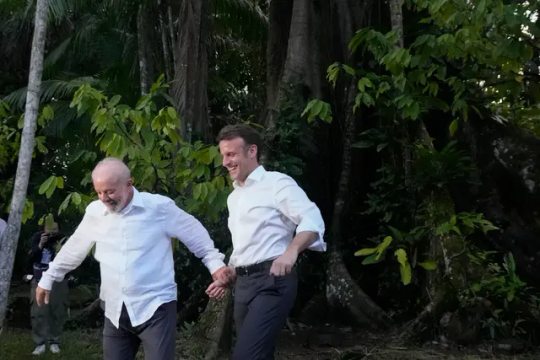
It was the head-of-state photo session seen round the internet. On Tuesday, the official social media accounts for Brazilian President Luiz Inácio Lula da Silva and French President Emmanuel Macron shared images of the two leaders together on a trip through the Amazon. In one photo, Lula and Macron grasped hands, smiling and peering out over the bow of a ship; in another, they bounded through the sun-dappled rainforest.
The subtext was clear: The trade agreement between South American customs union Mercosur and the European Union may be on life support, but Brazil and France are still doing big things together. That day, the two leaders announced a bilateral plan to invest $1.1 billion over four years in conservation and sustainable agriculture in the Amazon rainforest in Brazil and French Guiana, the latter a French overseas territory.
Macron’s visit to Brazil lasted until Thursday, when the French leader and Lula held an official meeting at Brazil’s presidential palace and signed a series of cooperation agreements.
“We are living in a Franco-Brazilian moment,” Macron’s office said. His delegation included officials from some of France’s biggest companies, including Carrefour and Airbus. Their meetings in Brazil intended to back up Macron’s assertion that the two countries can still grow their bilateral business in the absence of a new trade deal.
Whether they will be successful remains to be seen. Regardless, business is not the only reason Macron and Lula have sought closer ties. “Today, France is one of the developed countries that is most open and sensitive to certain demands of the global south,” said Maiara Folly, the executive director of Plataforma CIPÓ, a Brazilian think tank.
Continue reading.
#brazil#brazilian politics#politics#france#french politics#environmentalism#amazon rainforest#luiz inacio lula da silva#emmanuel macron#international politics#foreign policy#mod nise da silveira#image description in alt
3 notes
·
View notes
Text
When Thomas Paine was like “these are the times that try men’s souls” he literally didn’t even know. His soul was never tried that hard. In 2023 the average person’s soul is tried more strenuously than Thomas Paine’s ever was. He couldn’t even make it past the “let’s not be hypocrites talking about the brutality of the british while we are literally currently killing native americans out of some manifest destiny white european sense of entitlement bullshit” test meanwhile now we’re all trying to figure out how we can, individually, be so harmless and knowledgeable so as to stop the actual apocalypse from decimating entire communities and ecosystems leaving nothing but plastic and nuclear waste in its wake. We feel guilt over things Thomas Paine didn’t even know about and wouldn’t have cared about it he did. Our plebian guilt. However the quote kinda goes off. Also he was sorta right when he said “yet it is folly to argue against determined hardness; eloquence may strike the ear and the language of sorrow draw forth the tear of compassion, but nothing can reach the heart that is steeled with prejudice.” The hypocrisy of this obviously went completely over his head re: the genocide of indigenous people which he was part of, but what do we expect from men born in like the 1700s. The Enlightenment could only shine its bright torch so far down the cavern of old white men’s hearts. Anyway. Unfortunately I need to actually do my homework instead of reading these 18th century pamphlets
6 notes
·
View notes
Text
So I sorta refuse to listen to The Magnus Archives Season 5 because I just do not vibe with JMart and I actively dislike Martin (extensive reason for that, uh, here.) Although I suppose I have to get to season 5 because of my recent writing project.
But anyone who enjoys/ enjoyed TMA, I have some podcast recommendations for you if you didn’t find them already:
The Amelia Project
Where the Stars Fell
The Storage Papers
ETA 17/01/24:
Mistholme Museum of Mystery, Morbidity and Mortality
Cellar Letters
Malevolent
You need to be okay with swearing (loads of swearing) for WTSF and you need to be okay with Death being extensively thematised and somewhat ridiculed for TAP
Religious imagery is getting kinda weird in both WTSF and TSP but I’m so far intrigued rather than put off.
And a side-note: Season 5 of TAP is coming up (12th May) and will apparently feature not just Ben Meredith but also Jonny Sims as a guest voice actor
It might seem counter-intuitive but I wold suggest you check out the TAP Anniversary Special to get a feeling for the main character. Then you go back and start at Season 1, the story only really picks up at season 2 but trust me, it’s intriguing and will hook you!
What I love about TAP aside from its premise and story is that it’s a European podcast. It feels inherently European rather than English or French or contained to any one nationality. And this comes through quite early on and very strongly. I love that! The characters are fun, whimsical and quirky. The premise has its charme and it has a “case of the week” feeling to it even while the overarching story picks up weight. There’s really a lot I like about it.
Like, I only got into TSP and WTSF because I was antsy for Amelia Project to update again. (Sorry, no offence.) Which doesn’t change the fact that I wholeheartedly recommend WTSF and TSP. (And maybe you can get into other podcasts from the Rusty Quill Network or Fable & Folly Network; I just couldn’t yet because they didn’t really catch my interest as much.)
For WTSF, huh… I don’t know which episode I would point you towards there, best start from the beginning. Although WTSF Episode 7 is a good hook, probably. It’s a bit ‘Good Omens’-esque and very fun, even though I occasionally need the transcripts pulled up to catch everything.
And TSP was supposed to be an anthology, I think, but it very very quickly devolved into a solid storyline so best to just start with the first episode and binge a few. The story will start puzzling together and making sense.
#podcasts#tma podcast#the amelia podcast#starsfell podcast#wtsf podcast#WTSF#where the stars fell#the amelia project#amelia project#the storage papers#storage papers#storage papers podcast
19 notes
·
View notes